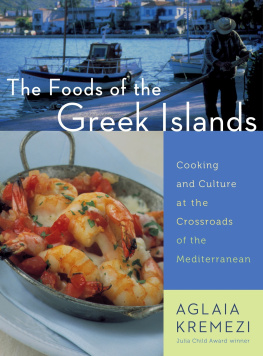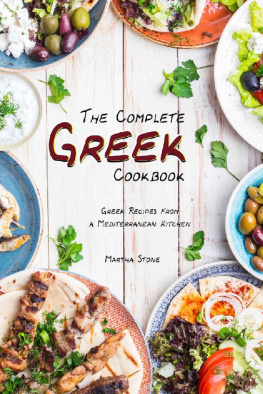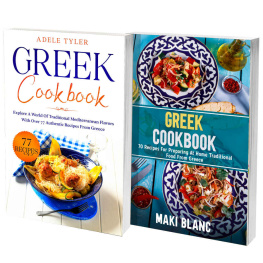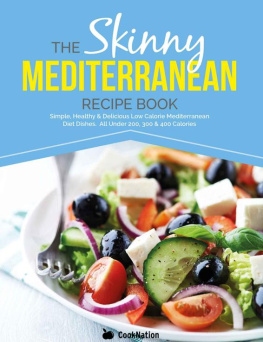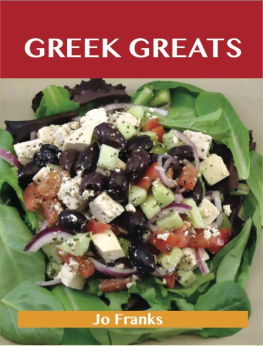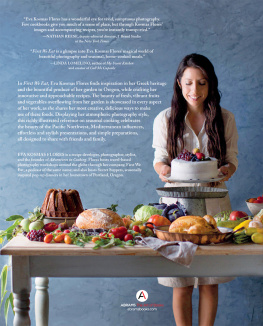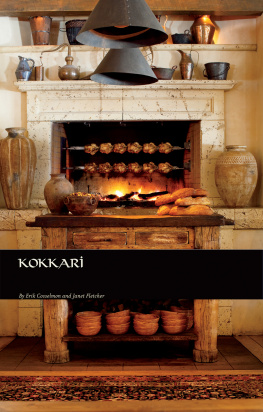Contents
ACKNOWLEDGMENTS
I cant thank my editor, Rux Martin, enough for embracing my work with such enthusiasm and devotion. Working with Rux for the first time was a truly enriching experience. I am similarly indebted to Sarah Jane Freymann, my dear friend and agent, who is a constant source of inspiration for me. Many thanks also to assistant managing editor Lori Galvin-Frost and designer Anne Chalmers.
My cooking is based on the foods that my mother, Frossoula Kremezi, prepared every day in our house. Tireless, well organized, intelligent and discreet, my mother has provided me with the best model in life that a woman could dream of. I owe a lot to my grandmother Anna Patiniotis, as well as to my aunt Katina Patiniotis, both great cooks.
I collected the material for this book over the course of many years. Although I keep extensive notes, I worry that I may miss thanking some of the generous people who helped me discover the foods of their region, by sharing their recipes, letting me read their mothers or grandmothers kitchen ledgers or simply by mentioning an old dish.
I would like to start by thanking the hardworking Vasso Kritaki and Yannis Mandalas on Chios, as well as Eleni Prochori on Syros, because they are among the very few Greek public servants who understand the importance of preserving the traditional recipes and use the resources of their regional governments to try and record them. I am really grateful to Achilleas Dimitropoulos for sharing with me his vast knowledge concerning the variety and the ways of cooking fish and seafood; also to Giorgos and Maria Koutsoumbis for uncovering the secrets of the cooking of Lesbos; and, on the same island, Christina and Dimitris Panteleimonitis, for their immense help and hospitality. I learned a lot from Viktoria Athanasiadou and her friends Evridiki Kalogeraki, Katina Xirouhaki, Virginia Bertaki and all the women of the Cultural Center of the Diocese of Chania, Crete, who invited me to taste the best foods of their region, cooking and sharing recipes with me. Many thanks to Kalliopi Delios from Avgonima, Chios, one of the most accomplished cooks I know, and, on the same island, Thomas Karamouslis, who shared so many stories and recipes. I am also grateful to the family of Yannis Choremis, who let me read his late mothers extensive kitchen notes; thanks to Katina Kritouli, from Pitios; Marionga Bobari, from Chios Town; and especially to Stefanos Kovas, an inspired chef devoted to the traditions of that island. Frosso Podotas, Kali and Virginia Nikolaki, Bety and Panagiotis Patiniotis and Irene Kali are only some of the cooks of Astypalaia who shared their recipes with me over the years. Popie and Nikola Papanikola let me pick vegetables from their wonderful garden there.
Many thanks to Kostas Prekas and Irene and Stefania Gianisi, from Syros; also to Margarita Marouli, Flora Stefa and Stamatis Paouris from Kea; to Morfi Diakogiorgou, from Karpathos; Christos Danassis from Folegandros; and Maria Primikiri, who gave me marvelous recipes from Folegandros, also providing clever substitutions for some hard-to-find island ingredients. I am grateful to my dear friend and accomplished cook Despina Drakaki and her mother, Pantelia Kortianou, from Paros. On Kythera, I owe many thanks to Vassilis Haros, Eleni Kalligerou, Eleni Koroneou, the bakers Giannis Koroneos and Giorgos Kasimatis and especially Elenara (Eleni Kasimati) from Drymonas, who spent a whole day with me making the cracked wheat and sour milk pasta of the island. On Santorini, I want to thank Giorgos Hatziyannakis, the owner of the wonderful Selini restaurant, and also my friend Katerina Vassiliadou. On Cyprus, I am grateful to Claire Serafim, for her knowledge and hospitality; to the veteran chef and teacher Marios Mourtzis; and also to Emilia Ekonomou, Andromachi Markidou, Panagiota Kyriakou, Maria Hartoupalou, Despoula Andreou and Christos Georgiou, as well as to my friend Niki Bahariou.
Many thanks to the fellow cooks, authors and journalists who have written booksin Greekon the cooking of their region and unselfishly compared notes and answered my questions: Dora Parisi, author of Tastes of the Aegean (with recipes from Lesbos), who tirelessly cooked many dishes for me; Nikoletta Foskolou, author of Traditional Recipes from Tinos, who not only shared recipes but sent me her mothers homemade cheeses; Michalis Magoulas, who let me read his book The Cooking of Ithaca before it was published; Eleni Troullou, author of Delicacies from Sifnos, and her husband, Antonis. Very special thanks to Ninetta Laskari, author of a marvelous book of history, memories and recipes, Corfu, a Glimpse in Time 12041864, who, with her writings and our lengthy conversations, introduced me to the authentic old recipes of her island. To Nikos and Maria Psilakis, who have collected an unbelievable number of recipes from all parts of Crete in both their books, Traditional Cuisine of Crete and Olive Oil: The Civilization of the Olive Tree, and to my dear friend Myrsini Lambraki, author of The Wild Greens and Olive Oil: 5,000 Years of Taste and Civilization.
For helping me make some sense out of the long and complicated history of island foods, I thank Phylis Bober, author of Art, Culture and Cuisine: Ancient and Medieval Gastronomy, and Andrew Dalby, author of Siren Feasts: A History of Food and Gastronomy in Greece; also Fred Plotkin, who was immensely helpful, with his vast knowledge of Italian foods, in comparing island recipes to the modern Venetian and Genoese ones. Thanks as well to cheese expert Daphne Zepos, for suggesting substitutes for Greek cheeses.
Paula Wolfert, my dear friend, was again, as she has always been, ready to answer questions about specific dishes and techniques, using her vast knowledge of Mediterranean foods. Additionally, she also helped me compile the list of sources.
Last, but not least, I would like to thank the Livanos familyand especially John, Nick and Chryssawho created Molyvos, a New York restaurant that treats Greek cuisine with respect, something that couldnt have been accomplished without the talent of chefs Rick Moonen and Jim Botsacos.
MEZE
MORE THAN JUST APPETIZERS
DOMATA ME KOPANISTI
Blue Cheese and Tomato Spread
THIS DELICIOUS spread from Olympi and other villages of southern Chios is made with the local tiny and intensely flavored tomatoes and the sharp kopanistia blue-type spreadable cheese, very similar to the ricotta forte of Italys Puglia. Neither of these two key ingredients is available outside the island, but I was determined to find substitutes, because I love this spread. In the summer, use ripe red tomatoes and bake them to concentrate their flavorin other seasons, good-quality canned tomatoes are fine. Because the more common blue cheeses lack the pungency of kopanisti, add a few tablespoons of rum or vodka. Good fruity olive oil binds all the flavors together.
Serve with plenty of fresh crusty bread or and/or some cut-up raw vegetables.
MAKES 6 TO 8 SERVINGS (ABOUT 2 CUPS)
- pounds ripe tomatoes, cored, halved and seeded
- cup crumbled blue cheese, preferably aged Gorgonzola, at room temperature

